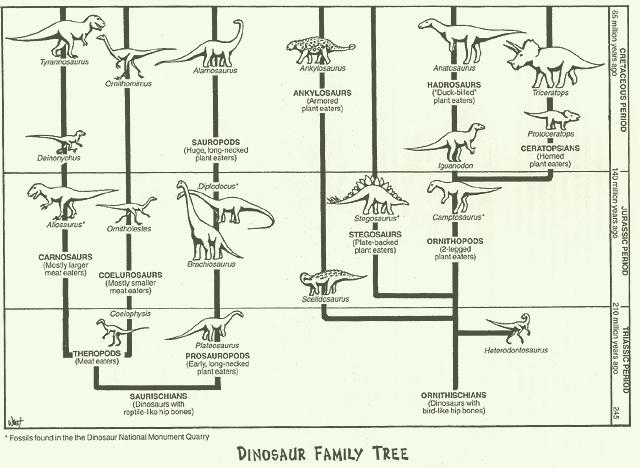How are Dinosaurs Classified?
As is probably obvious to the average dinosaur observer, dinosaurs often share characteristics. Some have sharp teeth, some have large heads or long necks, some walk on two legs, some on four, etc. These characteristics lead scientists to classify the dinosaurs according to these characteristics. Evolutions in these families over the years often lead to alterations resulting in a different family.

History of Classification
Although the science of classifying a species or group of life began early, Aristotle being one of the first known to do so, in 1735 the first widely defined form of Classification was set forth as the Linnaean system. In 1887 dinosaurs were divided into two general groups: Saurischia and Ornithischia. Saurischia generally had a lizard-like hip and Ornithischia had a bird-like hip. Practically all dinosaurs fit into these two categories. Later in the 1950's a new form began to be used known as The Cladistic system which is now the system more widely used by paleontologists.The Linnaean System
The Linnaean system was named after a Swedish botanist named Carl von Linné who invented the system. This method works by placing dinosaurs in groups and then moving on to smaller groups with less members of that category. These groups include kingdom, phylum, class, order, family, genus, and species. This however limits its freedom. Because of the complexity of evolution it is nearly impossible to set a fixed number of levels. Therefore cladistics was adopted as a way of classifying with more freedom to work with. However, the Linnaean system is still used for a more general public, such as consumer books, etc.The Cladistic System
The clasdistic system began in the early 1950's and was developed slowly growing in popularity in the 1980's and 1990's. This method is also known as the phylogenetic classification. Cladistics function by grouping dinosaurs into groups called clades. These clades track the evolutionary history of the animals. For instance, all dinosaurs in the Saurischia clade will always have the lizard-like hip and all dinosaurs in the Theropoda clade (a division of the Saurischia clade) will always be bi-pedal meat-eaters, but will also posses the lizard hip. Another example could be that the mammal clade all posses hair. Clasdistics were adopted in an attempt to better organize the ever-growing Linnaean system, which attempted to put too much information into an oversimplified system.
Copyright © 2005-2010 Calvin & Rosanna Hamilton. All rights reserved.